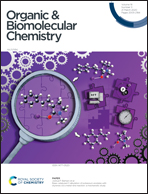Magnetically recoverable silica catalysed solvent-free domino Knoevenagel-hetero-Diels–Alder reaction to access divergent chromenones†
Abstract
A three-component domino Knoevenagel-hetero-Diels–Alder (DKHDA) reaction between 1,3-dicarbonyl, aldehydes/ketones, and alkenes/alkynes leading to the divergent synthesis of chromenones, dihydrochromenones, and spirocyclic chromenones is reported. The reaction was carried out under solvent-free conditions using a magnetically separable silica (Fe3O4@SiO2) catalyst. While two component DKHDA reactions are known, this is the first example of a three component DKHDA reaction involving 1,3-dicarbonyl, ketones, and alkynes producing spirocyclic pyranone derivatives. Twenty-six different highly substituted chromenones were synthesized using this methodology. A wide substrate scope due to the multicomponent nature of the reaction, high atom economy, the use of inexpensive and non-toxic recyclable silica as the catalyst, and solvent free reaction conditions make it an advantageous process. The catalyst was characterized using different analytical techniques such as XRD, IR, HRTEM, VSM, and TGA. Based on the earlier reports a mechanism has also been proposed.

- This article is part of the themed collection: Catalysis & biocatalysis in OBC


 Please wait while we load your content...
Please wait while we load your content...